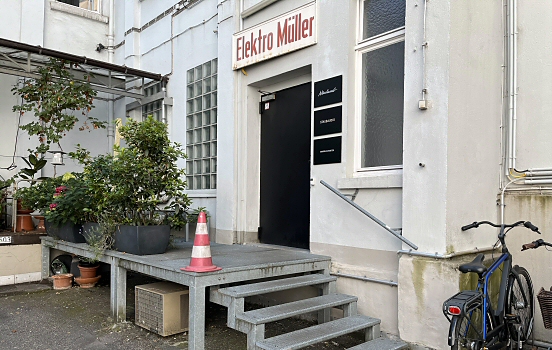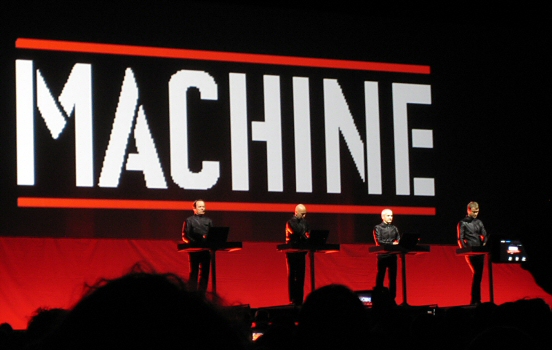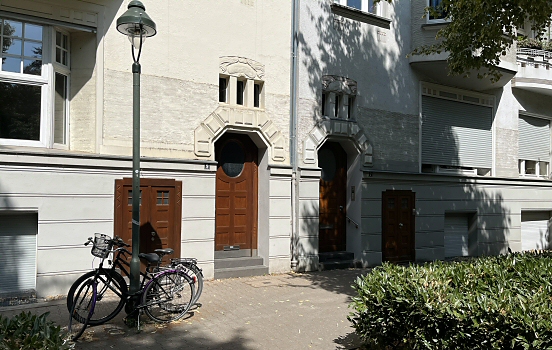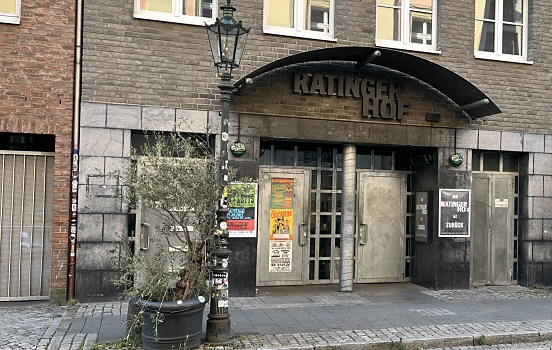Pilgrims have been been attracted to places of worship since ancient times. Whether they do cross-shaped hand gestures in front of a piece of wood or walk in circles around a cube in a desert city, there appears to be certain rites associated with most branches of faith. The reasoning behind the odd behavior may not be entirely obvious to any rational observer, but rationality is usually thrown out the back door anyway on these occasions.
For the black-clad music cult of analogue electronic music, a decrepit courtyard at Mintropstraße 16 in Düsseldorf is among the holiest of holy. The very womb which spawned an entire universe of sound to its acolytes. My pilgrimage journey has taken me to the former location of Kraftwerk’s Kling Klang studio. In this church of electronic music, the hymns contain elements of robots, radio activity and Autobahn.
 Walking on holy ground at former location of Kraftwerk’s Kling Klang studio.
Walking on holy ground at former location of Kraftwerk’s Kling Klang studio.
Düsseldorf is second largest city of the Rhineland, often associated with steel industry and altbier. For some reason it has also been a veritable Petri dish of artificial sounds. After the early contributions from composers such as Brahms and Mendelssohn, there were Krautrock pioneers such as NEU!, Neue Deutsche Welle sounds from DAF (Deutsch Amerikanische Freundschaft) and industrial noise from Die Krupps.
 Kraftwerk in Denmark 2009.
Kraftwerk in Denmark 2009.
And then there was Kraftwerk. There have been several constellations during the decades, but the most classic setup consisted of Ralf Hütter, Florian Schneider, Karl Bartos and Wolfgang Flür. The fantastic four created a unique sound which inspired pretty much everyone in the music business.
 Peaceful afternoon at Berger Allee 9.
Peaceful afternoon at Berger Allee 9.
More bands appeared in Düsseldorf, such as Der Plan, Propaganda, Rheingold and Liaisons Dangereuses. The sound of disaffected youth punching holes through the West German conservatism. Music for road trips with no destination but total psychic escape. The Düsseldorf scene wasn’t about sex, drugs and rock&roll. It was about the machine. Cold, relentless, hypnotic. And somehow, beautiful.
If you look carefully, ghosts of that synth-punk spirit still linger. I walk past Berger Allee 9, where Wolfgang Flür, Karl Bartos and Emil Schult lived for a few years. I sit alone sipping on a dark Altbier in a dirty brauhaus where the wallpaper hasn’t changed since 1967, next to Ratinger Straße 10 where artists such as Jürgen Engler (Die Krupps), Gabi Delgado (DAF) and Claudia Brücken (Propaganda/OMD) used to party half a century ago.
 Speaking with ghosts at Ratinger Straße 10.
Speaking with ghosts at Ratinger Straße 10.
I arrive at Hauptbahnhof, the large train station where once Kraftwerk recorded sound to their album Trans-Europe Express, released in 1977. The inner sleeve of the vinyl edition contains a photo where the fab four posed inside the station, which feels appropriate since the songs include celebrations of the European railway service.
As I leave Düsseldorf by train going westbound, I have Trans-Europe Express currently playing in my earpods, while reading a Kraftwerk biography. Cultist behavior indeed.
Half a decade may have passed since the four men composed the album, but the concept is timeless. Europe endless.
Comments
No comments yet.
Leave a reply